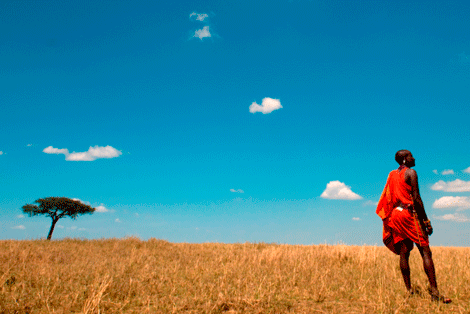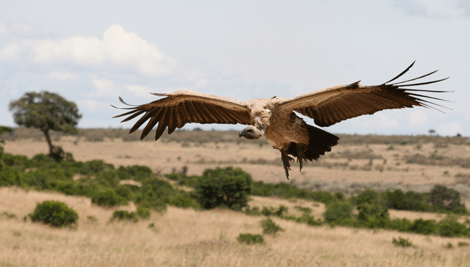On the world's second largest continent, Andrew Woodward finds both peace and danger at the legendary Cottar Safari
The rain had stopped. The room was silent, bar the soft sound of footsteps outside. I sat up in bed, momentarily confused as to where I was. As my eyes slowly became accustomed to the dark, I took in my surroundings – an antique writing desk, a sherry decanter and crystal glasses on my bedside table next to an oil lamp – that I could make out through the fine gauze of the mosquito net. Then I heard the shuffling of feet again, this time by the flaps of the tent. It came flooding back; I was comfortably ensconced in the most luxurious tent I had ever seen. This was the complete antithesis to the image of camping holidays in Britain that has been burnt into my memory.
A large four-poster bed dominated the spacious room that during daylight hours offered incredible views of the vast plains of the Serengeti, which spread out to the horizon and could be relished from the comfort of one’s own bed. The soft shuffling sound outside was a Masai tribesman whose job it was to protect guests from anything that decided to pay a visit in the wee small hours of the morning.

How the journey began
It was a few days before that I arrived at the small airport of Wilson in the suburbs of Nairobi, after a short drive from Jomo Kenyetta International Airport. The tiny Cessna Caravan taxied up to collect me with eight other passengers and delivered us to our destination: Keekorok airstrip in the Masai Mara.
We were given a little moment of excitement as we approached the airstrip apparently side on, only for the pilot to give a little tweak of the rudder and reward us with a gentle landing. Departing the airport in Cottars’ specially converted Toyota Landcruiser, we set off for a two-hour trip to the safari camp. There are not many airport shuttle buses around the world that offer views of ostrich, giraffe, hyena, jackal, lion, vulture, elephant, zebra, buffalo, impala and wildebeest on the drive to their resort.
Thoroughly spoilt by the abundant wildlife and breathtaking views, we were soon at Cottars’ 1920s Mara Safari Camp, resplendent in its own concession on the edge of the Masai Mara and bordering Tanzania, that no other operator can access. This allows guests to enjoy the 360-degree views of the Masai Mara with no one else but themselves, their guide and a multitude of wildlife.
Only Cottars’ vehicles can venture off the paths and get up close to the animals – the Landcruiser has no windows, the front and sides are completely open to the elements and anything else that may care to enter. It was both exciting and unsettling.
During the migration that takes place from June through to August, Cottars have sole use of their concession, which is also where the migration begins and ends. You’ll get to enjoy unparalleled views of the wildebeest, while in the nearby Masai Mara, the other visitors will be sharing their views with a host of other “vandebeest” – otherwise known as the Toyota Hiace vans that proliferate and spread across the plains during the peak season.
Living history
The following morning I was awoken from my dreams about prowling leopards by the houseboy rapping gently on my tent, laden with hot coffee and warm muffins as I readied myself for the dawn safari. If this is how they did it in the 1920s then I think I was born in the wrong decade. It was easy to imagine donning one’s crisp linen suit, pith helmet and heading out for the day to bag a couple of big game animals before returning to the pleasant sound of the clink of ice in a G&T while sitting around a roaring fire discussing the days events.
After a memorable morning chasing warthogs and getting very close to a very large lion, we stopped on a rocky outcrop overlooking the Masai Mara – a safe distance of at least 300 metres from where we’d just seen the impressive beast – and sat outside the vehicle on our picnic furniture for a hearty breakfast.
After a gruelling morning out big game hunting, I got to sit down again for a first-class lunch in the mess tent surrounded by the history of Cottars. The photographs on the walls highlight the history of the family, beginning with Charles Cottar, who had come out from America in 1919, inspired by President Theodore Roosevelt’s famous big game hunting trip to East Africa a century ago, to become the first family of East African safaris. The family lineage continues through to this day with the present patriarch Calvin Cottar.
The main tent is filled with family memorabilia from gramophones, pith helmets and old books, to chaise longues, zebra-skin rugs and a selection of animal trophies adorning the wall from when this was one of Africa’s leading big game hunting destinations. Thankfully, times have changed, but Cottars is evidently proud of its heritage that spans the last century. The soundtrack from the film Out of Africa accompanies lunch, and it’s quite easy to be completely absorbed by the surroundings and imagine, for a short while at least, that you are either Karen Blixen or Denys Finch Hatton.
The camp has made several subtle concessions to modern technology. There is wifi and mobile coverage, and if in desperate need, the manager’s office allows for the use of their laptop. However, guests are requested to turn off their mobiles when they are in the mess tent, which is greatly appreciated especially at the communal dinner where guests share their day’s safari anecdotes over the impressively sized sundowners, free-flowing drinks and tall stories.
After lunch I roused myself lazily from my daydreams and took myself off for a massage in the open-sided spa tent that allowed me to enjoy the cool breezes while enjoying the spellbinding natural vista. Despite my masseuse’s wonderful skills at removing the knots, I still managed to drift off for a few indulgent moments of sleep, lulled by the haunting lullaby of the calls and sounds of the African plains. Capturing a few moments of rest was essential as I needed all my energy and mental alertness for the late afternoon adventurous walking safari which allows guests to get as close to this magnificent natural world as possible.

Out in the wild
It was certainly an adventure but more in the sense of being thoroughly enjoyable and educational. My extremely knowledgeable guide Douglas was a veritable mine of information. He could tell from the droppings whether we were on the trail of a male or female giraffe. If you press for details, you will be told that the male can carry on walking during defecation while the female has to stop to go – hence a different distribution. You can also learn to tell whether the zebra prints you see are from a pregnant female – the hoof marks are further apart due to the spreading of the hips. I also got an in-depth appreciation of the impressive local termite community and the medicinal uses of several of the local plant species, including the fact that the local henna plant is actually part of the mint family.
If my mind was prone to wandering slightly during these impressive botanical lectures, it wasn’t due to my lack of interest in the subject matter, but more to do with my examinations of the nearby thickets. There was the unnerving feeling that it was us being watched rather than us doing the watching. We were lucky enough – or unlucky, depending on your adrenaline requirements – not to encounter an angry rogue buffalo, a rampaging bull elephant or the 15-strong pride of lions. Although most of the time what we saw were supposedly harmless animals such as zebra, Masai giraffe, dik dik and impala, only the day before I saw a fully grown male lion (that requires 70kg of flesh at every meal, I was cheerfully informed) disappear into a thicket not far away from where I stood. There were also animal skulls of various sizes and numerous bones scattered along the route we took – evidently somebody else’s favoured killing ground.
In keeping with the century-old traditions of Cottars, my guide was armed with a First World War 0.458 Winchester rifle, while bringing up the rear was a local Masai tribesman and eagle-eyed animal spotter, Kiringot, who was armed with his traditional spear. Earlier I’d seen Douglas put three rounds in that antiquated rifle, and it did little to ease my growing trepidation. The other piece of advice I’d been given was “Don’t run” – well, not until I was told to, and then I guess it was every man for himself. It was with great relief that I saw the Landcruiser emerge stealthily from the gloaming.
Over another fine dinner with the other guests, I mentioned my considerable lack of faith in only having one rifle between the three of us, that it only had three rounds and the unlikelihood of it saving us from, say, a madly charging elephant.
Douglas, who despite several inane questions during our outings was always patience personified, assured me he would have put the first round high into the head to stun the animal, and that two rounds would have been sufficient, as he continued his dinner without missing a beat. It left me wondering if, maybe, it would have been just a tad more interesting to glimpse something in the thickets? No, on second thought, I’m quite content with my safari experience, and I have lived to tell the tale.
Information
Cottars 1920s Camp rates (per person) for 2011:
High season: Jul 1-Sep 30; Dec 21-Jan 2
Sharing: US$860 Single: US$990
Mid-season: Jan 3-Mar 15; Jun 1-Jun 30; Oct 1-Dec 20
Sharing: US$700 Single: US$850
Green season: Apr 16-May 31
Sharing: US$490 Single: US$570
These prices do not include flights to the Masai Mara, airstrip transfers or Park and Reserve Fees.
How to get there
Kenya Airways (www.kenya-airways.com) flies from Hong Kong to Jomo Kenyetta International Airport in Nairobi via Bangkok. Ethiopian Airlines (www.flyethiopian.com) flies from Bangkok to Addis Ababa, where passengers can take connecting flights to Nairobi. Emirates (www.emirates.com) and Qatar Airways (www.qatarairways.com) serve the Kenyan capital from Dubai and Doha respectively.








